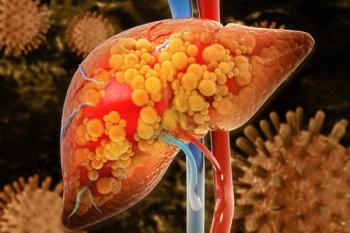
Missed Hepatitis B Treatment Opportunities in the US Increase Health Risks
Key Takeaways
- A large percentage of US patients eligible for HBV treatment remain untreated, despite effective therapies reducing adverse outcomes like cirrhosis and hepatocellular carcinoma.
- Disparities in HBV treatment exist across age, sex, and race, with older age and male sex associated with higher treatment odds.
Most US patients eligible for hepatitis B virus (HBV) treatment remain untreated, raising risks of liver disease and complications.
Most US patients eligible for
Significant Treatment Gaps in HBV Care Highlight Missed Opportunities
Despite untreated HBV being linked to earlier mortality, higher all-cause and liver-related death, and a 10% to 25% lifetime risk of developing hepatocellular carcinoma (HCC), only 29% of qualifying patients in the US
Although oral nucleoside analogues (NAs) do not cure HBV, they have demonstrated long-term safety and efficacy in reducing adverse HBV outcomes such as cirrhosis, liver decompensation, and HCC.1 Treatment initiation criteria vary across guidelines worldwide, but all recommend that patients with advanced fibrosis or cirrhosis receive therapy.
Previous studies suggested low treatment uptake across select US groups, but it remains unclear whether these findings apply to the broader population with HBV. To address this, the researchers conducted a cross-sectional study examining HBV treatment across the US. They also analyzed women of childbearing age (18-44 years), a group with increasing chronic HBV prevalence in some states, to identify potential missed opportunities for preventing mother-to-child transmission (MTCT).
The study used data from the TriNetX Dataworks-USA Network, which
Treatment eligibility was determined in accordance with the 2016 and 2018 American Association for the Study of Liver Diseases HBV practice guidelines. Therefore, individuals qualified if they met any of the 3 criteria: advanced fibrosis; diagnosed cirrhosis or liver decompensation; or elevated HBV DNA and alanine aminotransferase levels.
Additionally, treatment was defined as evidence of a prescription for peginterferon alfa-2a or NAs. The researchers used RxNorm codes, which standardize drug names and unique identifiers, to identify HBV therapy, as claims data integrate information from multiple systems that use different sets of drug names.
Disparities Persist in HBV Treatment Across Age, Sex, and Race
Among the 14,693 individuals in the TriNetX database with available laboratory data, 8594 were eligible, of whom 2134 (24.8%) received treatment. The overall median (IQR) age was 46 (36-37) years and was similar among those treated (49 [38-61] years) and untreated (45 [35-56] years). The cohort contained slightly more female than male patients, but a greater proportion of males (904/4171; 21.7%) qualified for treatment than females (538/4423; 12.2%).
By race, Asian patients comprised the largest proportion of the study population (n = 3356; 39.1%), followed by Black patients (n = 2367; 27.5%), White patients (n = 1481; 17.2%), and those of unknown or other race (n = 1390; 16.2%). Despite this, White patients were most likely to qualify for treatment (471/1481; 31.8%), followed by Black patients (363/2367; 15.3%), Asian patients (423/3356; 12.6%), and those of unknown or other race (185/1390; 13.3%).
Multivariable analyses found older age to be associated with greater odds of treatment (OR for >65 years of age, 1.51; 95% CI, 1.27-1.78), as well as female patients having reduced odds of treatment compared with male patients (OR, 0.67; 95% CI, 0.60-0.75). Additionally, meeting any of the 3 treatment qualification pathways was associated with greater treatment odds, with 60.0% (352/587) of patients diagnosed with cirrhosis or decompensation receiving care, as well as 56.7% (410/723) with advanced fibrosis, and 57.2% (414/724) with elevated HBV DNA and ALT criteria.
As for race, lower treatment odds were observed for Black patients (OR, 0.66; 95% CI, 0.58-0.75), White patients (OR, 0.80; 95% CI, 0.69-0.93), and those of unknown or other race (OR, 0.72; 95% CI, 0.69-0.93) compared with Asian patients.
“Our findings confirm the existence of important gaps and differences in HBV treatment that have been previously reported in select subgroups but also extend these observations to a broader national-level population,” the authors wrote.
Similar patterns were observed among the subgroup of female patients of reproductive age. Patients aged between 36 and 44 years had significantly lower odds of treatment than those aged between 18 and 25 years (OR, 0.64; 95% CI, 0.44-0.92). Compared with Asian patients in this subgroup, significantly lower odds of HBV treatment were observed among the Black patients (OR, 0.42; 95% CI, 0.31-0.56), White patients (OR, 0.47; 95% CI, 0.32-0.71), and those of unknown or other race (OR, 0.61; 95% CI, 0.45-0.85).
“Given the availability of safe and effective measures to prevent MTCT, these findings highlight an important gap in the prevention of negative HBV-related outcomes,” the authors wrote.
Addressing Treatment Gaps Through Clinician Education, Targeted Interventions
The researchers concluded by acknowledging their limitations, including that the dataset lacked geographic identifiers, which prevented location-based analyses. Also, HBV treatment was based on prescriptions rather than confirmed fills or adherence. Therefore, actual treatment rates may be lower. Nonetheless, the researchers underscored that their findings highlight the need for teaching clinicians about the importance of treating qualifying patients.
“Education of clinicians on HBV management and identification of effective interventions to address treatment disparities are needed and may positively impact patients’ lives and reduce the public health burden of HBV-related liver disease,” the authors concluded.
References
- Wong RJ, Telep LE, Wentworth CE, et al. Hepatitis B virus treatment gaps in the US. JAMA Netw Open. 2025;8(11):e2542744. doi:10.1001/jamanetworkopen.2025.42744
- Polaris Observatory Collaborators. Global prevalence, cascade of care, and prophylaxis coverage of hepatitis B in 2022: a modelling study. Lancet Gastroenterol Hepatol. 2023;8(10):879-907. doi:10.1016/S2468-1253(23)00197-8
- Topaloglu U, Palchuk MB. Using a federated network of real-world data to optimize clinical trials operations. JCO Clin Cancer Inform. 2018;2:1-10. doi:10.1200/CCI.17.00067
Newsletter
Stay ahead of policy, cost, and value—subscribe to AJMC for expert insights at the intersection of clinical care and health economics.













































